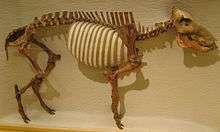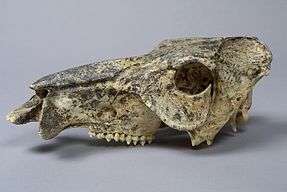Platygonus compressus
| Platygonus compressus Temporal range: Pleistocene | |
|---|---|
 | |
| Platygonus compressus skeleton | |
| Scientific classification | |
| Kingdom: | Animalia |
| Phylum: | Chordata |
| Class: | Mammalia |
| Order: | Artiodactyla |
| Family: | Tayassuidae |
| Genus: | †Platygonus |
| Species: | †P. compressus |
| Binomial name | |
| Platygonus compressus Leconte, 1848 | |

Platygonus compressus, the flat-headed peccary, is an extinct mammal species from the Tayassuidae-family, that lived in North-America during the Pleistocene. It was first described in 1848 by John L. Leconte.[1]
Description
The flat-headed peccary was about 75 cm (29.5 in) in shoulderheight and about 30 kg (66.1 lb) in weight.[2] Other sources have estimated it to be similar in size to the European Wild Boar.[3] Sizes differ between the place they have been found.[4]
Fossil skulls suggest a small brain, but a good sense of smell and sight. It has been suggested that the nasal cavity provided filtration for cold, dry and dusty air.[5][6] Platygonus compressus had elongated limbs, a short humerus, broad and erect thoracic vertebrae and a large scapula. Therefore it has been suggested that this species may have been fleeter on foot that modern peccary species.[3] Otherwise they probably appeared very similar to their closest living relative, the Chacoan peccary.
Distribution and habitat
The flat-headed peccary was widespread throughout North America. Fossils have been found from New York to California, from Wisconsin to Mexico and further south in South America. An Individual has even been found as far north as the Yukon.
Platygonus compressus lived in a great variety of habitats and had a wide environmental climate tolerance. This species roamed North American Boreal Forest and Tropical Rainforest in South America.[3][5]
Ecology
Flat-headed peccarys are often found in small groups up to 12 individuals. It is likely that Platygonus compressus lived in varying herd numbers from 2-100, as well as modern peccary species. It is believed to have been an open forest browser. Fossil teeth show adaptation for coarser vegetation.
Frequent roaming of caves have not been reported for this species. At Bat Cave in Missouri 98 individuals have been found together. Caves could possibly have been used for protection from extreme weather.[3][5]
References
- ↑ Wagner, George (December 1903). "Observations on Platygonus Compressus Leconte". The Journal of Geology. 11: 777–782. Bibcode:1903JG.....11..777W. doi:10.1086/621113. JSTOR 30055574.
- ↑ "Platygonus compressus". Fossilworks. Retrieved 2017-05-02.
- 1 2 3 4 Nye, April Season, "Pleistocene Peccaries from Guy Wilson Cave, Sullivan County, Tennessee." (2007). Electronic Theses and Dissertations. Paper 2115. http://dc.etsu.edu/etd/2115
- ↑ Slaughter, Bob H. (April 1966). "Platygonus compressus and Associated Fauna from the Laubach Cave of Texas" (PDF). American Midland Naturalist. 75: 475–494. doi:10.2307/2423406.
- 1 2 3 Zazula; Kuhn, Grant; Tyler (2014). Ice Age Mammals of Yukon. Yukon: Yukon Beringia Interpretive Centre. pp. 24–25. ISBN 978-1-55362-705-0.
- ↑ Hoare, Richard D. (May 1964). "Pleistocene Peccary Platygonus Compressus Leconte from Sandusky County, Ohio". The Ohio Journal of Science. 64: 207–214.